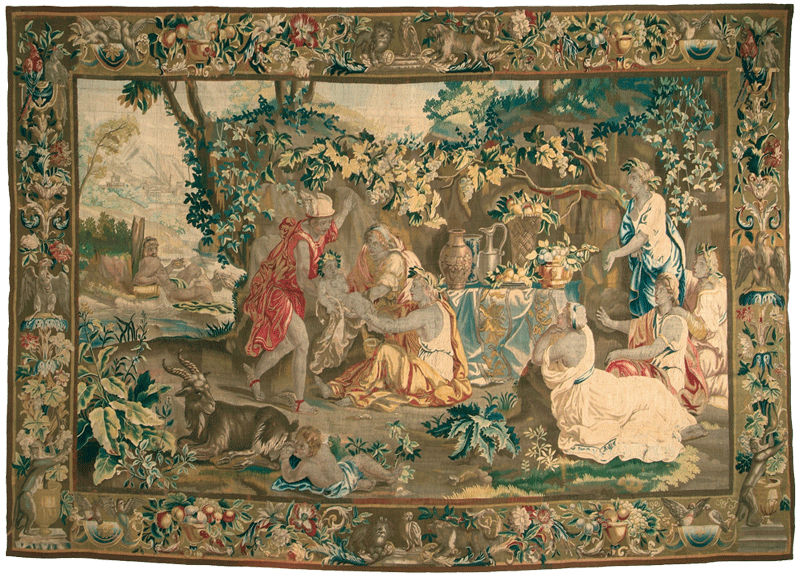
CONTEMPORARY PARAPHRASES OF AN EIGHTEENTH-CENTURY BRUSSEL'S TAPESTRY
The catalogue of the ‘Kárpít2’ exhibition featured an expert historical study by Emőke László. In this, the author also discussed the background of the mythological scene depicted on the classical tapestry that served as the basis for the Web of Europe work. According to the story, Jupiter appeared in the house of Semele, who was already pregnant with Bacchus by him, but the lightning bolts in which he was wreathed covered the mother-to-be in flames, burning her to death. Jupiter tore the unborn Bacchus from Semele’s womb and sewed him into his thigh. In the scene depicted, Mercury, Jupiter’s messenger, is entrusting the infant Bacchus to the care of the nymphs living in the Mt. Nysa region. At the middle point of the tapestry stands the figure of Mercury – wearing a red tunic, winged helmet, and winged sandals – handing over a baby, namely the infant Bacchus. At the right edge is a group of nymphs enthralled by the scene. In the background, we see the nymphs’ vine-decked grotto and a table in front of it that is heavily laden with fruit and jugs. To the left, Silenus is cooling himself in a brook. In the foreground of the composition, a few smaller shrubs can be seen, along with an infant being suckled by a goat. In the bordure are platters of fruit and garlands of flowers, while in each of the bottom corners there is a monkey hugging a vine-stock and in each of the top corners two parrots. The coloration is rich: very many shades of red, green, blue, yellow, and brown can be observed on the tapestry. In the middle of each of the horizontal sides is an owl, next to which there is a lion and a dog. In the last quarter of the seventeenth century, Brussels tapestry-weaving was strongly influenced by the Manufacture des Gobelins in Paris: attraction to mythological and allegorical themes, figures depicted in pleated antique attire, landscapes reflecting the influence of Poussin and Claude Lorrain, and more vivid coloration are all indicative of French influence. One of the most productive cartoon-drawers in this style was Louis van Shoor (1666–1726), the designer of this series of tapestries. He used as models prints made by Jean Dughet and Jean Versini on the basis of Poussin’s painting showing the birth of Bacchus. (See Emőke László’s paper on sixteenth–seventeenth-century tapestries based on Ovid’s Metamorphoses from the collection of the Museum of Applied Arts, Budapest, in the ‘Kárpít2’ exhibition catalogue, Budapest, 2005, pp. 25–26.)